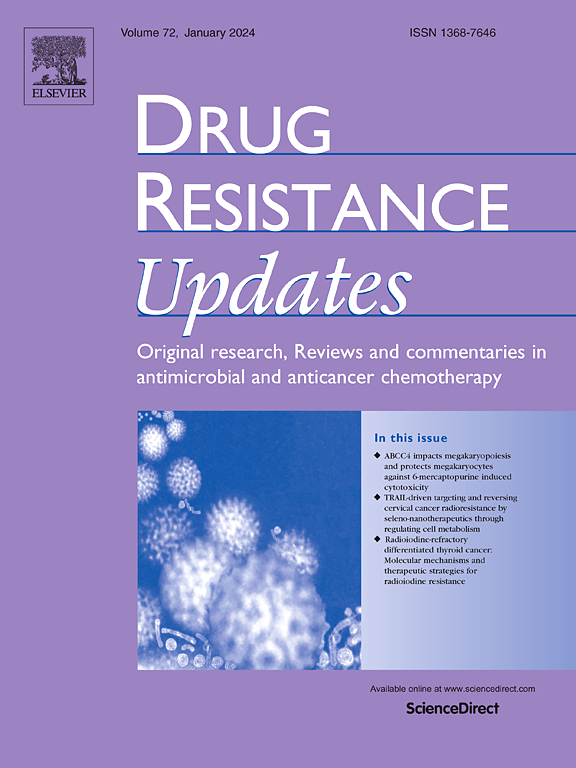Role of the sulfur-containing amino acid-ROS axis in cancer chemotherapeutic drug resistance
IF 15.8
1区 医学
Q1 PHARMACOLOGY & PHARMACY
引用次数: 0
Abstract
Chemotherapeutic drug resistance remains a major barrier to effective cancer treatment. Drug resistance could be driven in part by adaptive redox remodeling of cancer cells. Paradoxically, drug-resistant malignancies exhibit elevated reactive oxygen species (ROS), as well as amplified antioxidant defenses, which enable cancer cell survival under therapeutic stress. Central to this adaptation is glutathione (GSH), the predominant cellular antioxidant, whose synthesis relies on sulfur-containing amino acids (SAAs) – methionine and cysteine. This review delineates the metabolic interplay between methionine and cysteine in the transsulfuration pathway, highlighting their roles as precursors in GSH biosynthesis. We systematically summarize the key enzymes that drive GSH production and their contributions to resistance against platinum-based drugs and other chemotherapeutics. In addition to GSH synthesis, we summarize the roles of GSH antioxidant systems, including glutathione peroxidases (GPXs), peroxiredoxins (PRDXs), and thioredoxins (TRXs), which are critical in chemotherapeutic drug resistance through ROS scavenging. Recent advances reveal that targeting these enzymes, by pharmacologically inhibiting transsulfuration enzymes or disrupting GSH-dependent antioxidant cascades, can sensitize resistant cancer cells to ROS-mediated therapies. These findings not only clarify the mechanistic links between SAA metabolism and redox adaptation but also provide practical approaches to overcome chemotherapeutic drug resistance. By analyzing metabolic and redox vulnerabilities, this review highlights the therapeutic potential to restore chemosensitivity, offering new options in precision oncology medicine.
含硫氨基酸- ros轴在癌症化疗耐药中的作用
化疗耐药仍然是有效治疗癌症的主要障碍。耐药性可能部分是由癌细胞的适应性氧化还原重塑驱动的。矛盾的是,耐药恶性肿瘤表现出活性氧(ROS)的升高,以及抗氧化防御的增强,这使得癌细胞能够在治疗压力下存活。这种适应的核心是谷胱甘肽(GSH),主要的细胞抗氧化剂,其合成依赖于含硫氨基酸(SAAs) -蛋氨酸和半胱氨酸。本文综述了蛋氨酸和半胱氨酸在转硫途径中的代谢相互作用,强调了它们作为谷胱甘肽生物合成前体的作用。我们系统地总结了驱动谷胱甘肽产生的关键酶及其对铂类药物和其他化疗药物耐药的贡献。除了GSH的合成外,我们还总结了GSH抗氧化系统的作用,包括谷胱甘肽过氧化物酶(GPXs)、过氧化物还毒素(PRDXs)和硫氧还毒素(TRXs),它们通过清除ROS在化疗耐药中起关键作用。最近的进展表明,通过药理学抑制转硫酶或破坏gsh依赖的抗氧化级联反应,靶向这些酶可以使耐药癌细胞对ros介导的治疗敏感。这些发现不仅阐明了SAA代谢与氧化还原适应之间的机制联系,而且为克服化疗耐药提供了实用的方法。通过分析代谢和氧化还原脆弱性,本综述强调了恢复化疗敏感性的治疗潜力,为精准肿瘤医学提供了新的选择。
本文章由计算机程序翻译,如有差异,请以英文原文为准。
求助全文
约1分钟内获得全文
求助全文
来源期刊

Drug Resistance Updates
医学-药学
CiteScore
26.20
自引率
11.90%
发文量
32
审稿时长
29 days
期刊介绍:
Drug Resistance Updates serves as a platform for publishing original research, commentary, and expert reviews on significant advancements in drug resistance related to infectious diseases and cancer. It encompasses diverse disciplines such as molecular biology, biochemistry, cell biology, pharmacology, microbiology, preclinical therapeutics, oncology, and clinical medicine. The journal addresses both basic research and clinical aspects of drug resistance, providing insights into novel drugs and strategies to overcome resistance. Original research articles are welcomed, and review articles are authored by leaders in the field by invitation.
Articles are written by leaders in the field, in response to an invitation from the Editors, and are peer-reviewed prior to publication. Articles are clear, readable, and up-to-date, suitable for a multidisciplinary readership and include schematic diagrams and other illustrations conveying the major points of the article. The goal is to highlight recent areas of growth and put them in perspective.
*Expert reviews in clinical and basic drug resistance research in oncology and infectious disease
*Describes emerging technologies and therapies, particularly those that overcome drug resistance
*Emphasises common themes in microbial and cancer research
 求助内容:
求助内容: 应助结果提醒方式:
应助结果提醒方式:


